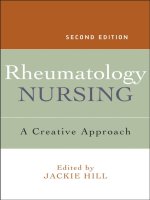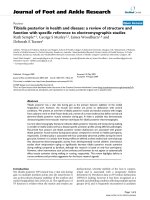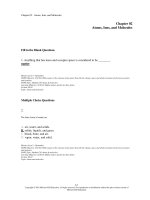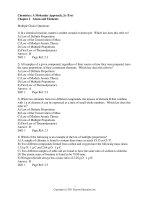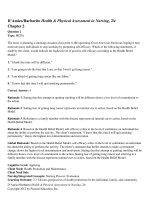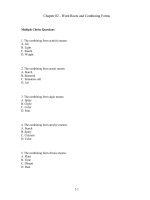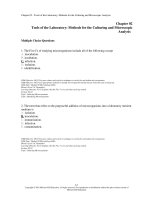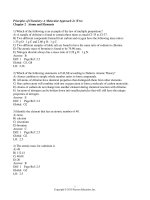Nutrition health and disease a lifespan approach 2nd edition
Bạn đang xem bản rút gọn của tài liệu. Xem và tải ngay bản đầy đủ của tài liệu tại đây (24.54 MB, 743 trang )
CONTENTS
Cover
Titlepage
Preface
Acknowledgements
Aboutthecompanionwebsite
Abbreviations
Glossaryoftermsusedinthisbook
CHAPTER1:Introductiontolifespannutrition
1.1Thelifespanapproachtonutrition
1.2Theconceptofbalance
1.3Theindividualresponsetonutrition
1.4Assessmentofnutritionalstatus
1.5Nutritionalepidemiology:Understandingdiet–diseaserelationships
1.6Dietaryreferencevalues
References
Additionalreading
CHAPTER2:Beforelifebegins
2.1Introduction
2.2Nutritionandfemalefertility
2.3Nutritionandmalefertility
2.4Preparationforpregnancy
References
Additionalreading
CHAPTER3:Pregnancy
3.1Introduction
3.2Physiologicaldemandsofpregnancy
3.3Nutrientrequirementsinpregnancy
3.4Dietinrelationtopregnancyoutcomes
3.5Nauseaandvomitingofpregnancy
3.6Cravingsandaversions
3.7Gastrointestinaldisturbancesinpregnancy
3.8High-riskpregnancies
References
Additionalreading
CHAPTER4:Fetalnutritionanddiseaseinlaterlife
4.1Introduction
4.2Thedevelopmentaloriginsofadultdisease
4.3Evidencelinkingmaternalnutritiontodiseaseinlaterlife
4.4Mechanisticbasisoffetalprogramming
4.5Implicationsoftheprogramminghypothesis
References
Additionalreading
CHAPTER5:Lactationandinfantfeeding
5.1Introduction
5.2Thephysiologyoflactation
5.3Theadvantagesofbreastfeeding
5.4Trendsinbreastfeedingbehaviour
5.5Situationsinwhichbreastfeedingisnotadvised
5.6Alternativestobreastfeeding
References
Additionalreading
CHAPTER6:Nutritionandchildhood
6.1Introduction
6.2Infancy(birthtofive)
6.3Childhood(5–13)
6.4Obesityinchildren
References
Additionalreading
CHAPTER7:Nutritionandadolescence
7.1Introduction
7.2Physicaldevelopment
7.3Psychosocialdevelopment
7.4Nutritionalrequirementsinadolescence
7.5Nutritionalintakesinadolescence
7.6Potentialproblemswithnutrition
References
Additionalreading
CHAPTER8:Theadultyears
8.1Introduction
8.2Changingneedsfornutrients
8.3Guidelinesforhealthynutrition
8.4Diseasestatesassociatedwithunhealthynutritionandlifestyle
References
Additionalreading
CHAPTER9:Nutrition,ageingandtheelderly
9.1Introduction
9.2Theageingpopulation
9.3Theageingprocess
9.4Nutrientrequirementsoftheelderly
9.5Barrierstohealthynutritionintheelderly
9.6Commonnutrition-relatedhealthproblems
References
Additionalreading
APPENDIX:Anintroductiontothenutrients
A.1Classificationofnutrients
A.2Carbohydrates
A.3Lipids
A.4Proteins
A.5Micronutients
Index
EndUserLicenseAgreement
ListofTables
Chapter01
Table1.1Theacutephaseinflammatoryresponsetotraumaorinfection.
Table1.2Themetabolicresponsetoinjuryandinfectionincreasesrequirementsfor
energyandprotein.
Table1.3Thethreestagesofirondeficiency.
Table1.4Anthropometricmeasuresusedtoestimatebodycompositionandnutritional
status.
Table1.5Advantagesanddisadvantagesofdietaryassessmentmethods.
Table1.6Definitionsofkeytermsinepidemiology.
Table1.7Studydesignsinnutritionalepidemiology.
Table1.8DefinitionsofdietaryreferencevaluetermsusedintheUnitedKingdom,
NorthAmericaandOceania.
Chapter02
Table2.1Reactiveoxygenspeciesandantioxidantsinbiologicalsystems.
Table2.2Environmentalsourcesofhumanexposuretoendocrine-disruptingchemicals.
Table2.3Organicfood,pesticideexposureandsemenquality.
Table2.4Factorsthatimpactonparentalhealthduringthepericonceptualperiod.
Chapter03
Table3.1Developmentofthehumanorgansduringgestation.
Table3.2OptimalweightgainforwomeninpregnancyisdependentupontheirprepregnancyBMI.
Table3.3Riskfactorsforpretermdelivery.
Table3.4Picabehaviours.
Table3.5USInstituteofMedicinerecommendationsformicronutrientsupplementation
inmultiplepregnancy.
Chapter04
Table4.1Theclassicalactionsofglucocorticoids.
Chapter05
Table5.1Thecompositionofhumanmilk.
Table5.2UKreferencenutrientintakes(RNI)forlactatingwomen.
Table5.3Thehealthbenefitsofbreastfeedingforwomenandtheirbabies.
Table5.4Definitionsofbreastfeedingbehaviour.
Table5.5Tenstepstosuccessfulbreastfeeding.
Table5.6Comparisonoffull-termandpreterminfantformulacomposition(selected
nutrients).
Chapter06
Table6.1Developmentalmilestonesforinfants.
Table6.2Acomparisonofnutrientrequirements*betweenadultsandchildrenunder
theageof5years.
Table6.3Complementaryfeedingstages.
Table6.4Energyrequirementsofchildren.
Table6.5Energyandsugarcontentofbeveragescommonlyconsumedbychildren.
Table6.6Geneticdisordersassociatedwithearly-onsetobesity.
Chapter07
Table7.1Sexualmaturationratings(Tannerstages).
Table7.2Acomparisonofnutrientrequirements*betweenadultsandchildrenaged
11–18years.
Table7.3Energyrequirementsofadolescentsaredependentuponphysiological
developmentandphysicalactivitylevel(PAL).
Table7.4Vegetariandietarypractices.
Table7.5Enhancersandinhibitorsofironabsorption.
Table7.6Diagnosticcriteriaforeatingdisorders.
Chapter08
Table8.1Generalguidelinesforintakeofsugars,fatsandsaltbyadults.
Table8.2Classifyingobesityusingbodymassindexorwaistcircumference.
Table8.3Globaldistributionofobesityinadults.
Table8.4WorldHealthOrganizationdiagnosticcriteriaforthemetabolicsyndrome.
Table8.5Referencerangesforplasmalipidsinadults.
Table8.6Normalandhypertensivebloodpressurereferences.
Table8.7Associationsbetweendietandlifestylefactorsandspecificcancers.
Table8.8EstimatesofriskofcancerassociatedwithhighBMI.
Chapter09
Table9.1Age-relateddeclineinphysiologicalfunctions.
Table9.2Dietaryreferencevalues(UnitedKingdom)forenergyandprotein.
Table9.3Causesofanaemiaintheelderlypopulation.
Appendix
TableA.1Commondietaryfattyacids.
TableA.2Theessentialandnon-essentialaminoacids.
TableA.3Theminerals:sources,functionsanddeficiencysymptoms.
TableA.4Thefatsolublevitamins:sources,functionsanddeficiencysymptoms.
TableA.5Thewatersolublevitamins:sources,functionsanddeficiencysymptoms.
ListofIllustrations
Chapter01
Figure1.1Theconceptofbalance.Thedemandsfornutrientscomprisemetabolicand
physiologicalprocessesthatutilizenutrients.Supplyisdeterminedbyintakesoffood,
availabilityofnutrientstoresanddenovoproductionofnutrients.
Figure1.2Theassociationbetweennutritionandhealth.Therequirementsofthebody
fornutrientswillbemetbyabroadrangeofintakes.Verylowandveryhighintakesof
anynutrientwillbeassociatedwithillhealth.Thetransitionfromintakesthatare
meetingdemandsandatwhichriskofdiseaseislowtointakesthatwouldbe
associatedwithdiseaseisnotabrupt.
Figure1.3Determiningnutrientrequirementsusingthebalancemethod.Precise
measurementsofnutrientintakeandofoutputbyallpossibleroutesenable
determinationofnutrientrequirements.Thehighestlevelofintakeatwhichbalancecan
nolongerbemaintainedwillindicatetheactualrequirementofanindividualforthat
nutrient.
Figure1.4Theindividualresponsetofoodiscomplexanddeterminedbyarangeof
modifiableandnon-modifiablefactors.
Figure1.5Singlenucleotidepolymorphisms(SNPs)arisewhentherearesinglebase
changesintheDNAsequenceofagene.Asallindividualscarrytwocopiesofagene,
thepolymorphismcanresultinindividualsbeinghomozygousorheterozygousfor
specificgenevariants.
Figure1.6TheCT677SNPofmethylenetetrahydrofolatereductase(MTHFR)
influencestheactivityoftheenzymeintissues.Thiscommonvariantofthegenecan
havesignificantimpactonfolatemetabolism.
Figure1.7Bodymassindex(BMI)iscommonlyusedtodefineandclassifyoverweight
andobesity.
Figure1.8Availabilityofanimalandplantproteinbyworldregion.Percapita
availabilityofproteinfromplantandanimalsourcescalculatedfromthe2004FAO
globalfoodbalancesheets.
Figure1.9Afoodfrequencyquestionnaireisusedtoestimatethehabitualconsumption
offoodstuffswithinthedietofanindividual.
Figure1.10Thedoublylabelledwatermethodisatechniqueusedtoassessenergy
expenditure.Subjectsconsumewatercontainingstableisotopesofhydrogenand
oxygen.Thiswaterreachesequilibriumwiththebodywater.Measuresofthedoubly
labelledwaterinsalivaandurineenableestimationofthelossof18O2frombody
water.Thatlosscanonlyoccurthroughproductionoflabelledcarbondioxide.Carbon
dioxideproductionisameasureofmetabolism.
Figure1.11Measuringtherelationshipbetweenanutritionalexposureandadisease
outcomeiscomplex,necessitatingcarefulepidemiologicaldesigns.Thesedesignsmust
considerappropriatesamplingintermsofsizeofpopulation,lengthofstudy,
measurementofdietandmeasurementofdiseaseoutcome.
Figure1.12Aconfoundingfactorisanadditionalfactorthatmayexplainthe
relationshipbetweenanexposureandanoutcome.Theconfoundingfactorisrelatedto
bothoutcomeandexposure,butdoesnotlieonthecausalpathwaybetweenthetwo.
Figure1.13Understandingoddsratios.a)Oddsratio(OR)isadescriptoroftheriskof
eventcomparedtoareferencegroup.Forthereference,theORissetat1.0.IfORis
lessthan1.0,thatindicatesdecreasedrisk.Ifmorethan1.0,itindicatesincreasedrisk.
b)ORisanestimateofriskandthequalityofthatestimatewilldependupon
methodologicalfactorsandbiologicalvariation.TherangeofpossiblevaluesforOR
isrepresentedby95%confidenceintervals.TheseareusedtodistinguishbetweenOR
estimatesthatshowasignificantrelationshipbetweenexposureandriskandthose
whichdonot.
Figure1.14Hierarchyofevidenceinnutrition–diseasestudies.Experimentsinanimals
orinvitrohavethelowestmethodologicalquality,whilerandomizedcontrolledtrials
andmeta-analysesareofhighestquality.
Figure1.15Researchdesignsinepidemiology.
Figure1.16Theassociationbetweenriskofnutrition-relatedriskandlevelofnutrient
intake.EAR,estimatedaveragerequirement;RNI,referencenutrientintake;UL,
tolerableupperlimit.
Figure1.17ThenormaldistributionasabasisforDRVs.UKDRVsarebaseduponan
assumednormaldistributionofindividuals’nutrientrequirementsandlevelofnutrient
intake.Theestimatedaveragerequirement(EAR)issetatthecentre(mean)ofthe
distribution.Thelowerreferencenutrientintake(LRNI)andreferencenutrientintake
(RNI)valuesareplacedtwostandarddeviationsbelowandabovethemean,
respectively.Thenutrientrequirementsofallbut5%ofthepopulationshouldtherefore
bemetbylevelsofintakebetweenthesetwovalues.
Chapter02
Figure2.1Maternalandneonatalmortality.a)Maternalmortalitydeclinedinmost
regionsoftheworldbetween1980and2008,butremainsmarkedlyhigherinthe
developingcountries.b)Thereisconsiderableglobalvariationinneonatalmortality,
withhighestmortalityintheAfricannations(figuresshownfor2009–2013inselected
countries).
Figure2.2Theendocrinecontroloffemalereproductivefunction.Themenstrualcycle
lastsforanaverageof28days.Thiscanbedividedintoadistinctfollicularphase
(days1–13)duringwhichoestrogen,LHandFSHstimulatefolliculardevelopment.
OvulationdrivenbyhighconcentrationsofLHandoestrogenoccursonday14.The
lutealphase(days15–28)isdrivenbyhormoneproductionfromthecorpusluteum,
whichproduceshighconcentrationsofprogesteroneandoestrogentopreparethe
uterineliningforimplantationofafertilizedembryo.Intheabsenceoffertilization,
feedbackinhibitionofprogesteronepromotesthedegenerationofthecorpusluteumand
menstrualbleeding.
Figure2.3Polycysticovarysyndrome(PCOS)isalleviatedbyweightloss.
Approximately50%ofwomenwithPCOSareoverweightandobese.PCOSsymptoms
canbereducedbyweightloss,achievedthroughincreasedphysicalactivityand
dietarychangeorbytreatmentwithmetformin.Metforminisananti-diabeticdrug,
whichactsbysuppressinghepaticgluconeogenesis.
Figure2.4Adiposetissue-derivedleptinandthehypothalamic–pituitary–ovarianaxis.
LeptinfromadiposetissuepromotesproductionofGnRH,FSHandLHandtherefore
hasastimulatoryeffectonthehypothalamic–pituitary–ovarianaxis.
Figure2.5Leptinreceptorsignallingcascade.Bindingofleptintothemembranebound
Ob-Rbreceptoractivatesmultiplesignallingpathways,includingthephosphoinositol3
kinase(PI3K)pathwayandtheRAS–MAPkinasepathway.Bindingofleptinactivates
JAK2,whichphosphorylatesSTAT3.FormationofphosphorylatedSTAT3complexes
drivesactivationoftranscriptionoftargetgenesincludingNPYandAgRP.Leptin
resistancedevelopsthroughleptinup-regulationoftheexpressionofsuppressorofthe
cytokinesignalling-3(SOCS3),whichinhibitstheJAK2–STAT3pathway.
Figure2.6ROSaredamagingwithinbiologicalsystems.a)Asectionofmembraneina
mammaliancellcomprisesthephospholipidbilayerwithatransmembraneproteinand
cellsurfaceproteins.b)Afterinteractionwithareactiveoxygenspecies,thesectionof
membraneisheavilydamagedduetothechainreactionsestablishedbytheoxidationof
macromolecules.Oxidativedamagetothelipidbilayer(lipidperoxidation)will
impactuponmembranepropertiessuchaspermeability.Damagetoproteinswillalter
conformationandimpactuponreceptor,signalling,transportandenzymefunctions.
Figure2.7Endocrinecontrolofmalereproductivefunction.Inmales,pulsatile
hypothalamicproductionofGnRHstimulatesthereleaseofFSHandLHwhich
stimulatetheproductionoftestosteroneandthedevelopmentofmaturesperminthe
testes.Testis-derivedinhibin-Bandtestosteronehavenegativefeedbackeffectsinthe
anteriorpituitaryandhypothalamusandtherebyregulatethehypothalamic–pituitary–
testicularaxis.
Figure2.8Theformationofmaturesperm.Spermproductioninthemalereproductive
tractconsistsofmitoticandmeioticdivisionsfollowedbyadifferentiationphasein
whichspermacquiretheirspecializedstructures.
Figure2.9Contemporarytrendsinspermcounts.Theassertionthatspermcountsfell
sharplybetweenthe1940sand1990shasbeenwidelydisputed.However,datafrom
recentsurveysusingrobustmethodologiesoftenindicateaprogressivedeclineovera
morerecentperiod.
Figure2.10Therelationshipbetweenmaleobesityandsubfertility.Obesityandinsulin
resistanceareacauseofinfertilityastheyinterferewiththenormalsecretionand
transportofandrogens.Asandrogensareactivatorsoflipolysis,furtheradiposityis
stimulatedbyimpairedactionoftheandrogens.
Figure2.11Theimpactofalcoholintakeonspermcountisminimal.Moderateintake
ofalcoholisnotassociatedwithadverseeffectsuponspermcounts.Hansenetal.
(2012)comparedmenconsuming96unitsofalcoholormorewithnon-consumers.
Martinietal.(2004)consideredanyalcoholconsumptionagainstnon-consumption,
andJooetal.(2012)evaluatedtheeffectof>33 galcohol/dayagainst<6.4 g/day.
Noneofthestudiesfoundastatisticallysignificanteffect.
Figure2.12Thestructuresofoestrogenandphytoestrogens.Phytoestrogenssuchas
genisteinanddaidzein(theprincipalsoyaisoflavones)haveasimilarchemical
structuretooestrogens,allowingbindingtotheoestrogenreceptors.
Figure2.13ThemetabolismofvitaminA.DietarysourcesofvitaminAdeliver
preformedretinol(fromanimalsources)orß-carotene.Retinolfromthedietorformed
withintheliverisusedtogeneraterhodopsinintheretinaandisconvertedtoretinoic
acidwhichmodulatesgeneexpressionviatheRAR/RXRreceptors.Retinoicacidcan
bemetabolizedtoanumberofintermediatesthatareknowntohaveteratogenic
propertiesinanimalsandhumans.
Figure2.14VitaminAsupplementationandfetalmalformations.Therelationship
betweenvitaminAsupplementationandfetalmalformationswasexploredina
populationofSpanishwomen.Thedatashowsoddsofmalformationsassociatedwith
vitaminAinamultivitaminsupplement,higherlevelsofvitaminAinamultivitamin
supplementandmegadosesupplementsofvitaminAalone.
Figure2.15USfortificationwithfolicacidhasbeenmoreeffectivethan
supplementationintheUnitedKingdominthepreventionofneuraltubedefects.In
1992,theUnitedKingdomintroducedguidelinesrecommendingsupplementationwith
folicacidinpreparationforpregnancytoreduceNTDrisk.TheUnitedStates
introducedmandatoryfortificationofgrainswithfolicacidin1998.UKdata
correspondsto1990(pre-policy)and1999(post-policy)andshowsadeclineof2%.
USdatacorrespondsto1995–1996(pre-policy)and1999–2000(post-policy)and
showsadeclineof27%.
Chapter03
Figure3.1Componentsofmaternalweightgainduringpregnancy.
Figure3.2Changesinironstatusduringpregnancy.Thetotalamountofhaemoglobinin
circulation( )increases,butduetorisingplasmavolume,thehaemoglobin
concentration( )decreases.
Figure3.3TheroleofGLUT4inglucosetransport.GLUT4translocationisakeystep
inthemovementofglucoseacrosscellmembranes.Inpregnancy,theformationofIRS1–PI3-Kcomplexesisinhibited,leadingtoinsulinresistance.
Figure3.4Biosynthesisoflong-chainpolyunsaturatedfattyacidsfromessentialfatty
acids.
Figure3.5Contributorstomaternalironstatusduringpregnancy.Replenishmentofiron
storeswillbelessinwomenwhodorecommencemenstruationsooner(not
breastfeeding)butmaybeaidedbyimprovedabsorptionofdietaryironinthethird
trimesterofpregnancy.
Figure3.6MetabolismofvitaminD.
Figure3.7Obesityinpregnancyisariskfactorforadverseoutcomes.
Figure3.8Prevalenceofmorbidobesity(BMI > 35 kg/m2)inpregnancy.
Figure3.9Periodontaldiseasemaybeariskfactorforpre-eclampsia.Meta-analysis
of15studiesshowsasignificantrisk,butthisismostlyattributedtostudieswherethe
diagnosisofperiodontitiswasnotrobust.Dataareshownasoddsratio ± 95%
confidenceinterval.*Significantlydifferent(P < 0.05).Sgolastraetal.(2013).
Figure3.10ThepathophysiologyofPE.
Figure3.11Riskofcaesareanbirthisgreaterinwomenwhoareoverweightorobese.
Figure3.12Thetemporalassociationbetweensymptomsofnauseaandvomitingin
pregnancyandconcentrationsofhCG.
Figure3.13NVPisassociatedwithreducedriskofpretermdelivery.Threehundred
pregnantwomenwerequestionedaboutsymptomsofNVPinthefirsttrimesterof
pregnancyandtheoutcomeofpregnancywasfollowedup.Womenwhoreportedno
NVPsymptomsweresignificantlymorelikelytogivebirthpriorto37weeksgestation.
Figure3.14Hyperemesisgravidarumisaseriousconditionofunknownorigin.It
resultsinseveredehydrationandreducedfoodintake.
Figure3.15GDMisaconditionofmaternalinsulinresistance.Maternalinsulin
resistancedrivesglucoseacrosstheplacentatothefoetaltissues.Theensuingincrease
infoetalinsulinsecretiondrivesexcessivefoetalgrowthandleadstoLGA.
Figure3.16Thecharacteristicsoffetalalcoholsyndrome.
Chapter04
Figure4.1Progenitorcellsandstemcellshavethepropertyofplasticitywhereby
growthfactororcytokinesignalscantriggeradifferentiationresponseorcelldivision.
Thefatesofprogenitorcellsarelimitedtospecificlineagesofcellswithinatissueor
system,butembryonicstemcellsarepluripotentandinresponsetocuesduring
developmentcangiverisetoanycelltype.
Figure4.2Effectofsocio-economicstatusonbirthweight.SocialclassI,
professionals;classII,clericalworkers;classIII,skilledmanualornon-manual
workers;classIV,unskilledworkers;classV,unemployed.
Figure4.3SeasonalvariationinbirthweightamongchildrenbornintheGambia.
Womenarepoorlynourishedinthewetseasonandgivebirthtosmallerbabiesthanin
thedryseason.Supplementationofthedietwithenergy(431 kcal/day)inthewet
seasonremovedtheseasonaldifferenceinbirthweight,showingthatitwasrelatedto
nutritionalstatus.
Figure4.4Therelationshipbetweenmaternalnutrientintakeandbirthweight.Ina
studyof300pregnantwomen,theeventualbirthweightsoftheirchildrenwerenot
relatedtoenergya),proteinb)orothermacronutrientsinthefirsttrimesterof
pregnancy.Amongthemicronutrients,onlyironintakec)wasassociatedwithweightat
birth.
Figure4.5Influencesuponfetalgrowth.Thegrowthtrajectoryofthefetusis
determinedbythegenotype.Geneticallydeterminedgrowthratesmaybeconstrained
byinfluencesfromthemotherorplacenta.Thesecanactdirectlyonthefetaltissues,
forexample,maternalhormonescrossingtheplacenta,orindirectlybymodifyingthe
rangeorconcentrationofnutrientsreachingthefetaltissues.
Figure4.6Growthismorelikelytobeconstrainedinrapidlygrowingfetuses.Growth
ofthefetusisprimarilysetbythegeneticpotentialoftheindividual.Factorssuchas
maternalundernutritioncanconstrainthisgeneticgrowthrate.Theeffectsofconstraint
willbegreaterwheregrowthandthedemandfornutrientsandoxygenarehigh.Inthis
example,theslowlygrowingfetusachievesapproximatelythesameeventualbirth
weightastheundernourishedrapidlygrowingfetus,irrespectiveofnutritionalstatus.
Figure4.7TheDevelopmentalOriginsofHealthandDiseasehypothesis.Maternal
undernutritionpromotesfetalundernutrition,whichinturnwillslowfetalgrowthrates.
Therelationshipbetweenfetalundernutritionanddiseaseinlaterlifemaybedirectly
theresultoffetaladaptationstoundernutritionormayberelatedtotherestrictionof
fetalgrowthandorgandevelopment.
Figure4.8Bloodpressurein50-year-oldmenandwomengroupedbyweightatbirth
andplacentalweight.Foranybirthweightclass,bloodpressurewashigheras
placentalweightincreased.Foranyplacentalweightclass,alowerweightatbirthwas
associatedwithhigherbloodpressure.
Figure4.9Insulinresistancein50-year-oldmenandwomengroupedbyponderalindex
atbirth(PI)andBMIatage50.ForanyPIclass,insulinresistancewashigherasadult
BMIincreased.ForanyadultBMIclass,athinnessatbirthwasassociatedwithgreater
insulinresistance.QuartilesofPIare(1)<20.6 kg/m3,(2)20.6–22.3 kg/m3,(3)22.3–
25 kg/m3and(4)>25 kg/m3.
Figure4.10Globalproteinavailabilitystatistics.Dataextractedfrom2004FAOfood
balancesheets.Foodbalancemethodsonlydeterminetheproteinavailable(i.e.
producedthroughagricultureorimported)perheadofpopulation.Actualconsumption
willbebelowthefiguresshownandhighlyvariablewithineachregion(e.g.affluentvs
poor,urbanvsrural).Sixty-fivepercentoftheworldpopulationarelikelytoconsume
proteinatlessthantheUKreferencenutrientintakeandarethereforeatriskoflow
proteinintakeduringpregnancy.Manyindevelopingcountriesrelyonlower-quality
plantproteinsources.
Figure4.11Thethriftyphenotypehypothesis.
Figure4.12Theprincipleoftissueremodelling.Duringembryonicandfetallife,
progenitorcellsundergoroundsofproliferativecelldivision.Followingthis
proliferativephase,thecellsundergodifferentiationtoformdiversecelltypesthatwill
performthephysiologicalfunctionsofthematureorgan.Adverseenvironmentsduring
eitherphasewillmodifythecellnumbersortypesthatappearinthematureorgan.
Figure4.13Themodeofactionofnuclearreceptors.Nuclearreceptors(NR)are
typicallylocatedinthecytosolassociatedwithheatshockproteins(Hsp).Onbinding
ligand,theligand–receptorcomplexformsdimerswhichbindtohormoneresponse
elements(HRE)onDNA,wheretheypromotetranscription.Coac,coactivator;RNAp,
RNApolymerase.
Figure4.14Placental11ß-hydroxysteroiddehydrogenase(11ßHSD2)actsasabarrier
tothemovementofactiveglucocorticoidsbetweenmotherandfetus.a)Normal
gatekeeperfunctionsof11ßHSD2convertactivecortisoltoinactivecortisoneand
henceprotectfetaltissuesfromhormonesofmaternalorigin.Onlysynthetic
glucocorticoidssuchasdexamethasonemaypassacrosstheplacentaunchanged.b)In
theundernourishedmother,expressionof11ßHSD2inplacentaisdiminishedand
hencethefetaltissuesareoverexposedtoactiveglucocorticoids.
Figure4.15Programmingofhepaticlipidmetabolismbyamaternallow-proteindietin
therat.Pregnantratswerefedalow-proteindietthroughoutpregnancy.a)At18months
ofage,theiroffspringshowedhistologicalevidenceofhepaticsteatosis(arrowshows
whitelipiddepositswithinthelivertissue).b)ThemRNAexpressionoffattyacid
synthase,akeyenzymeinthesynthesisoflipid,wassuppressedinthelow-proteinexposedoffspringat1monthofage,butc)waselevatedintheolderanimals.
Figure4.16DNAmethylationandhistoneacetylationareepigeneticmechanismsthat
regulategenetranscription.CpGislandsinDNAmaybemethylatedorunmethylated.In
theunmethylatedstate,thehistoneproteinsassociatedwiththeDNAtendtobe
acetylatedandtheDNAislesstightlycoiled.Transcriptionfactorsandtranscription
machinerycanaccessgenepromotersandhencetheunmethylatedgenescanbe
expressed.Methylationleadstodeacetylationofhistonesandpreventstranscription.
Figure4.17Postnataltreatmentwithantihypertensivedrugsreverseprogramming
effectsofmaternalundernutrition.Pregnantratswerefedcontrolorlow-protein(LP)
dietsinpregnancy.Ongivingbirth,allanimalswerefedthesamediet,buthalfofthe
littersfromeachgroupweretreatedwithlosartan,anantagonistoftheangiotensinII
AT1receptorfor2weeks.Bloodpressurewasmeasured8weekslater.Blood
pressureofoffspringfromuntreatedLP-fedratswaselevatedcomparedtocontrols,
buttheLP-exposedratstreatedwithlosartanhadnormalbloodpressure.
Figure4.18Riskofdiseaseisaproductoftheinteractionbetweenthegenome,the
epigenomeandtheenvironment.Riskatanystageoflifewillbedeterminedbythe
interactionofmultiplegenotypes,theepigeneticmodificationofthosegenotypesand
exposuretotheenvironment,includingnutrition.Theresponsetotheenvironmentat
anystageoflifemayvaryastheepigeneticregulationofgenotypewillreflect
exposuresatearlierstages.
Figure4.19Programmingofbloodpressureacrossgenerations.Pregnantratswerefed
controlorlow-protein(LP)dietsinpregnancy.Ongivingbirth,allanimalswerefed
thesamedietandwhenadulttheoffspringwerematedtoproducefourseparatecrosses
(controlmale × controlfemale,controlmale × LPfemale,LPmale × controlfemale,LP
male × LPfemale).Bloodpressuresoffirst-generationandsecond-generationoffspring
weremeasuredat8weeksofage.F1,firstgeneration;F2,secondgeneration.
Chapter05
Figure5.1Theanatomyofthehumanbreast.Thebreastcomprises10–12lobules,each
containingmammaryalveolartissuewithassociatedlactiferousducts.Theducts
terminateatthelactiferoussinusesthatdischargeviathenipple.
Figure5.2Synthesisofhumanmilk.Milksynthesisoccursinthepolaralveolarcellsof
themammarytissue.Substratesformilkproductionareeithersynthesizeddenovo
withinthecytoplasmandGolgicomplexesofthealveolarcellorareimportedfromthe
maternalcirculationthroughendocytoticuptakeonthebasalsideofthecell.Lipid
dropletsandmaternalcirculation-derivedproteinsaredischargedtothealveolarlumen
byexocytosis.Lactose,caseinmicelles,waterandmicronutrientsaresecretedtothe
lumenfromtheGolgiapparatus.
Figure5.3Thestructureofacaseinmicelle.Micellesbindandtransportcalciumand
phosphateinmilk.Theinternalsub-micellescomprisehydrophobicαandβcaseins,
whilethoseontheexternalsurfaceofthestructuresincorporatehydrophilicκcasein
chains.
Figure5.4Theneuroendocrinecontroloflactation.Milkletdownisstimulatedby
activationofmechanoreceptorsinthenipple.Thehypothalamuscoordinatesthe
responsetostimulation,involvingoxytocinandprolactin,therebyensuringthatmilk
synthesisandreleaseoccursimultaneously.
Figure5.5BreastfeedingtrendsintheUnitedKingdomfrom1995to2010.
Figure5.6Globalprevalenceofexclusivebreastfeedingfor6months(2007–2011).
Figure5.7AttritionamongbreastfeedingwomenishighintheUnitedKingdom.A
significantproportion(25%)ofbreastfeedingwomengiveupwithinthefirst4weeks.
By4–10weeksafterbirth,only33%ofbabiesaresolelybreastfed.
Figure5.8Socio-economicfactorsareastrongdeterminantofbreastfeedingbehaviour.
ThreehundredpregnantwomenfromNorthampton,UnitedKingdom,wereinterviewed
regardingtheirbreastfeedingintentionsinthe32ndweekofpregnancy(Langley-Evans
andLangley-Evans,2003).Thedottedlineshowstheproportionofwomeninthe
UnitedKingdomwhowouldbeexpectedtobreastfeed(Hamlynetal.,2002).Social
classI,professionals;II,clericalworkers;IIINM,skillednon-manualworkers;IIIM,
skilledmanualworkers;IV,partlyskilledworkers;V,unskilledworkers.
Figure5.9Globally,aminorityofbabiesareborninbaby-friendlyhospitals.Most
industrializednationslagbehinddevelopingcountriesinensuringtheBFIstandards.
Figure5.10Inbornerrorsofmetabolismcanmakebreastfeedinghazardoustochild
health.Galactosaemiaandphenylketonurianecessitatethefeedingofspecialinfant
formulas.
Figure5.11Comparisonofthecompositionsofmilksfromhumansandcows,alongside
atypicalinfantformula.
Chapter06
Figure6.1Ratesofgrowthinpreschoolchildren.
Figure6.2Stuntingandwasting.Stuntingisdefinedasheightwhichistwostandard
deviationsormorebelowthemedianheightforageforanappropriatereference
population.Wastingisdefinedasweightwhichistwostandarddeviationsormore
belowtheweightforageforanappropriatereferencepopulation.
Figure6.3AUKsurveyof474mothersofyounginfantsshowedthatthemosttrusted
sourceofadviceonwhenandhowtointroducedcomplementaryfoodswastheir‘own
research’,whichincludedaccessingInternetarticlesandreadingbooks.General
practitionersweretheleasttrustedsourceofinformation(SprayandLangley-Evans,
unpublisheddata).
Figure6.4Thestructureofphyticacid.Phytatesarefoundinmanycerealsand
legumes,wheretheyoccurboundtoproteinsandstarches.Thephosphategroupsof
phyticacidareabletochelatecations,andasaresult,phytateinthegutwillreduce
bioavailabilityofmineralssuchaszinc,calciumandmagnesium.
Figure6.5Irondeficiencyanaemiahaslong-termeffectsoncognitivedevelopmentand
lifeopportunities.CostaRican25-year-oldswhohadeitherbeenchronicallyiron
deficient(IDA)orironsufficientininfancyweremorelikelytohavefailedto
completesecondaryschool,werelesslikelytobeintrainingduringearlyadulthood
andweremorelikelytobeunmarried.
Figure6.6Faddyeatinghasnomajoreffectonthegrowthofinfants.Nostatistically
significantdifferencesinweightorheightamong455Britishinfantsaged30months
werenotedwhentheywereclassifiedbyparentalreportoffaddyeating.ThriveIndex
isameasureofgrowthoverayear.
Figure6.7Socialdeprivationinchildren.Withindevelopedcountries,povertyis
definedasafamilyincomebelow50%ofthepopulationmedianwage.Levelsof
povertyexperiencedbychildrenarevariablethroughoutthedevelopedcountries,
generallybeinghighestineasternandsouthernEurope.Datashownrepresentsfigures
fortheperiod2002–2007.
Figure6.8Advertisingimpactsuponthesnackinghabitsofchildren.Infantswere
exposedto30 minofcartoonswithadvertisementsforeithertoysorsnackfoods.With
freeaccesstoarangeofsnacks,theexposuretofoodadvertsincreasedconsumption.
Figure6.9Boyswhomissbreakfastaremorelikelytobeobesethanthosewho
consumeabreakfastcerealorotherbreakfastfoodsonaregularbasis.
Figure6.10Bodymassindexcentiles.Themostrobustdefinitionsofoverweightand
obesityarebasedupontrackingthecurrentBMIcentileofanychildundertheageof18
throughtotheBMIvalueforthatcentileatage18.StandardBMIcut-offsof25and30
kg/m2foroverweightandobesity,respectively,canthenbeapplied.Onthisbasis,a
childfollowingthecentilemarkedAonthechartwouldbedefinedasobese,whilea
childfollowingthecentilemarkedBwouldbedefinedasoverweight.
Figure6.11Prevalenceofchildhoodobesityinselectedcountries.
Figure6.12Children’sdailyexposuretotelevisionorotherscreen-basedactivities.
Figure6.13Theadiposityrebound.Inearlychildhood,theweightgainofchildren
outstripstheirheightgain,andasaresult,BMIrisesrapidly.Beyondthefirstyearof
life,heightgaintendstoexceedweightgainandsoBMIdeclines.Betweentheagesof
4and8,theBMIbeginstoincreaseagainandthispointistermedtheadiposity
rebound.Havinganearlieradiposityreboundappearstobepredictiveofobesityin
childhood,anditcanbeclearlyseenonthegraphthatforchildrenonahigherBMI
centile,therebound(markedbythestars)occursatanearlierage.Earlieradiposity
reboundisnotedinformula-fedcomparedtobreastfedinfants.
Figure6.14Trackingofoverweight.Anindividualwhoseweight(bodyfatness)
classificationchangesfromchildhoodtoadulthoodisnotsaidtobetracking(e.g.line
Ashowsanadultonsetofoverweight).Whereweightclassificationremainsthesame
fromchildhoodtoadulthood(lineB)orfromadolescencetoadulthood(lineC),weight
istracking.Theevidenceoftrackingofoverweightisstrongestfromadolescenceto
adulthood.
Figure6.15Riskfactorsforcoronaryheartdiseaseinrelationtochildhoodoradult
overweight.AdultobesityisassociatedwithraisedcirculatingLDL-cholesteroland
lowerHDL-cholesterolconcentrations.Theseareestablishedriskfactorsforcoronary
heartdisease.Inadultindividualswhowereoverweightduringchildhood,therisk
profileassociatedwithobesityisnodifferenttothatseeninadultswhowereofnormal
weightinchildhood.Thesedatasuggestthatadultriskofcoronaryheartdiseaseisnot
directlyinfluencedbychildhoodweightstatus.NW,normalweight;OW,overweight.
Figure6.16Managingobesityinchildrenismoreeffectivewhereahealthyratherthan
arestrictivedietispromoted.Weightlosswassustainedforalongerperiodby
childrenwhowereadvisedtoincreasetheirintakesof‘healthy’foodsthanamong
childrenadvisedtoreduceintakeoffoodswithhighenergydensity.
Figure6.17Thepreventionofchildhoodobesitydependsupontheinvolvementof
parentsandfamilies,foodproducers,schoolsandgovernmentagencies.Noneofthese
stakeholdershavesufficientinfluencetobeabletotackletheobesityproblemin
isolation.
Chapter07
Figure7.1Accrualofleanandfatmassduringtheprepubertalandpubertalperiods.
Duringadolescence,thereisarapidincreaseintheleanbodymassofmalesand
females,coincidingwiththepubertalgrowthspurt.Fatmassalsoincreasesbuttoa
greaterextentinfemales.
Figure7.2Therelationshipofgrowthvelocitytopubertalstaginginboysandgirls.
Averagetimingsofpubertal(Tanner)stagingareshowninthelowerhalfofthefigure.
Agerangesbeneaththepubertalstagingboxesindicatethespreadofvaluesoverwhich
sexualmaturationbeginsandends.Heightvelocitycurvesatthetopofthefigureshow
thetimingsofthepubertalgrowthspurtingirls(——)andboys(––––)andthe
averageageofmaximalgrowthvelocity.Itisclearfromthefigurethatingirls,
accelerationofgrowthprecedespubertaldevelopment,whileinboys,thisacceleration
occursatamoreadvancedstage.
Figure7.3Thekeyendocrineeventsofadolescence.Adrenarcheandpubertyare
separateprocessesthatpromoteendocrinematuration.Developmentoftheadrenal
glandincreasessecretionofandrogensinbothmalesandfemales.Theadrenal
androgensstimulatedevelopmentofsecondarysexualcharacteristics.Pubertybegins
withthematurationofthehypothalamusandthestablerhythmofproductionofGnRH.
FSH,follicle-stimulatinghormone;LH,luteinizinghormone.
Figure7.4Thegrowthoflongbones.Longbonesexpandthroughactivitywithinthe
epiphysealgrowthplate,whichliesattheinterfaceoftheboneshaft(diaphysis)and
end(epiphysis).Newcartilagecells(chondrocytes)areformedattheepiphysealend
ofthegrowthplate,whilematurecellsonthediaphysealenddieandbecomecalcified.
Theboneextendsbyvirtueofthiszonepushingtheepiphysisawayfromthediaphysis.
Figure7.5Theaccrualofbonemass.Muchofthemassoftheadultskeletonis
depositedduringtheadolescentgrowthphase.Themostrapidrateofbone
mineralizationcoincideswiththepubertalgrowthspurt.Depositionofbonecontinues
beyondthecessationofgrowth,andpeakbonemassisachievedinthethirddecadeof
life.
Figure7.6Factorsthatinfluencethefoodchoicesandeatingbehavioursofadolescents.
Figure7.7Dietingbehavioursarecommonplaceamongadolescents,includingthose
whoarenotoverweight.
Figure7.8Snackfoodscompriseasignificantproportionofdailyintakesofenergy,
sugarsandtotalandsaturatedfatsamongadolescents.Thisproportionincreased
betweenthe1977/1978and2005/2006NHANESsurveysintheUnitedStates.
Figure7.9Thefemaleathletetriadisasyndromeofdisorderedeatingresultingin
reproductiveandskeletalabnormalities.Thesyndromeisassociatedwithhigh-level
participationinsportsthatemphasizebodysizeandappearance.
Figure7.10BNasacycleofbehaviourdrivenbypoorself-esteem.Individualswith
BNgothroughfrequentepisodesofbingeeatingfollowedbyuseoflaxativesand
emeticsorexcessiveexercisetocompensateforingestedenergy.Thebingeingisseen
asawayofdealingwithanxietyanddepressionlinkedtopoorself-esteemandfeelings
oflowself-worth.Feelingsofshamethatfollowthebinge–purgeepisodeactually
servetoreinforcetheinitialproblemandhencemaintainthebulimicbehaviour.
Figure7.11Adolescentpregnancyisassociatedwithanumberofadverseoutcomes
includingstillbirth.Mothersundertheageof20are1.4(95%CI1.2–1.6)timesmore
likelytohaveastillbirththan25–29-year-olds.
Figure7.12Themetabolismofalcohol.Alcohol(ethanol)canbemetabolizedthrough
cytosolic,microsomalorperoxisomalpathways.Cytosolicmetabolisminvolvesthe
enzymesalcoholdehydrogenase(ADH)andacetaldehydedehydrogenase1(ALDH1).
Wherethecytosoliccapacityisexceeded,microsomalmetabolismutilizesthe
cytochromeP450enzymes(CYP2E1andCYP4A1).Acetaldehydeproductsof
microsomalethanolmetabolismareclearedbyacetaldehydedehydrogenase2
(ALDH2).Peroxisomalcatalase(CAT)canalsocontributetoalcoholclearance.
Figure7.13ThereisaweakassociationbetweenalcoholconsumptionandBMIin
adolescents.InyoungerDutchadolescents,heavyorexcessiveintakewasassociated
withgreaterriskofoverweight,buttheeffectwasabsentinolderadolescents.
Moderateintake, 1–3glassesperoccasionperweekforgirlsand1–5forboys;heavy,
4–6glassesforgirlsand6–10forboys;excessive>7glassesforgirlsand>10for
boys.
Chapter08
Figure8.1Basalmetabolicratedeclineswithageinmenandwomen.Datashowbasal
metabolicrate(BMR)estimatesformenandwomenofaverageweight,derivedfrom
theSchofieldequations:Malesaged18–29 years:BMR = 0.063 × bodyweight + 2.869.
Malesaged30–59 years:BMR = 0.048 × bodyweight + 3.653.Femalesaged18–29
years:BMR = 0.062 × bodyweight + 2.036.Femalesaged30–59 years:BMR = 0.034
× bodyweight + 3.538.
Figure8.2TheEatwellplate.Thispictorialrepresentationoftherelativeproportions
offoodsfromeachoffivegroupsthatshouldbeincludedinahealthydietisusedas
oneofthekeyaidsinhealtheducationintheUnitedKingdom.
Figure8.3Symbolsusedinfoodlabelling.a)Aguidelinedailyamount(GDA)-based
foodlabel.GDAsonfoodlabelsrepresenttheaveragerequirementsofanadult
woman.Presentingfront-of-packGDAinformationonenergy,sugar,fatsandsaltis
intendedtoenableconsumerstomakehealthychoices.b)TheSwedishNationalFood
AdministrationKeyholesymbol.Onlyfoodsthatarelowinfat,sugarandsaltcancarry
thislogo,whichallowsconsumerstoidentifythefoodsthatcompriseahealthydiet,
bothinshopsandwheneatingout.
Figure8.4Weightlossisoftenfollowedbyregain.Weightlossinterventionsgenerally
resultinweightlossfortheirdurationincompliantindividuals.Weightregainwill
beginoncetheinterventioniscomplete,andfullregainoflostweightwillusually
occurwithina5-yearperiod.
Figure8.5Theglucosetolerancetest.Subjectsconsumeanoralloadof75 gglucose.
Thispromotesariseinbloodglucoseconcentrations.Bloodsamplesat2 hintothetest
candiscriminatebetweenhealthysubjects(glucoseshouldhavereturnedtothe
baseline,normalrangeofbelow110 mg/dl),subjectswhoareglucoseintolerant
(glucosewillremainabove140 mg/dl)andsubjectswithfrankdiabetes(glucosewill
remainabove200 mg/dl).
Figure8.6HbA1cpercentageisameasureofthedegreeofglycationofhaemoglobin
andassuchservesasamarkerforlonger-termbloodglucoseconcentration.Relatively
smallincreasesinHbA1careassociatedwithsignificantincreasesinriskof
cardiovasculardiseaseandnephropathy.Riskofcomplicationsincreasessharplywith
valuesof7.5%orgreater.
Figure8.7Schematicrepresentationoftheconsequencesofinsulinresistance.
Figure8.8Eventsleadingtotheformationofthefattystreakandatheroscleroticplaque.
ROS,reactiveoxygenspecies;VCAM,vascularcelladhesionmolecule.
Figure8.9Coronaryheartdiseasemortalityinmenandwomeninselectedcountries.
Figure8.10PlantstanolesterslowercirculatingLDL-cholesterolconcentrations.This
ispartiallyachievedthroughinhibitionofcholesterolester(CE)uptakefromthegut.
Thisincreasesendogenoussynthesis,butproductionofLDLisinhibited,andthe
reuptakefromcirculationisenhanced.Asaresult,circulatingLDLfalls.
Figure8.11Themethionineandfolatecycles.CBS,cystathionine-β-synthase;MS,
methioninesynthase;MTHFR,methylenetetrahydrofolatereductase;SAH,Sadenosylhomocysteine;SAM,S-adenosylmethionine;THF,tetrahydrofolate.
Figure8.12Saltsensitivityandresistance.Individualsaredefinedassaltsensitiveif
theingestionofasodiumloadinducesanincreaseinbloodpressureandiftheadoption
ofsodiumrestrictionleadstoacorrespondingdecreaseinbloodpressure.Individuals
withtheoppositeresponsearetermedsaltresistant.Saltresistanceisseenina
minorityofindividuals(20–25%ofthepopulation),whilemosthumansexhibita
degreeofsaltsensitivity.
Figure8.13Theeffectoflow-andhigh-saltdietsonsystolicbloodpressureina
Chinesepopulation;theGenSaltstudy.
Figure8.14Schematicrepresentationofthethreestagesoftumourigenesis:initiation,
proliferationandinvasion.
Figure8.15Xenobiotics(chemicalsthatarenotcomponentsofnormalmammalian
biochemistry)aremetabolizedviaphaseIandphaseIIsystems.PhaseImetabolism
generatesmetabolitesthatareconjugatedwithglutathione(phaseII)andfurther
compoundsthatenableurinaryexcretion.
Figure8.16InfectionofthegastricmucosawithHelicobacterpyloriisariskfactorfor
cancer.Thehostresponsetoinfectionpromotesinflammationandcelldamage.
Bacterialproductschangethenatureofthegastricmucosaandcanpreventapoptosis
andinhibittumoursuppressorfunctions.
Figure8.17CancerratesinmaleKoreanmigrantstotheUnitedStatescomparedtothe
nativeSouthKoreanpopulation.Migrationisassociatedwithsignificantlydecreased
prevalenceofcancersofthestomach,liverandgallbladder,butthesecancersstill
remainmorecommonthaninthefullUSpopulation.Migrationincreasedriskofcolon
andprostatecancers.
Figure8.18Theprogressionofanormalcelltoatransformedcellwithcancerous
potentialisdependentuponDNAdamage,afailuretorepairthatdamageandthe
evasionofsystemsthateliminatedamagedcells.Environmentalfactors,includingdiet,
interactwithgeneticfactorsatallstagesoftheprocess.
Figure8.19ContributionofobesityandoverweighttocancerriskinEuropeanmenand
women.
Figure8.20Possibleroutesfrommeatintaketocolorectalcancer.
Figure8.21Healthyvolunteersconsumedvegetarian,high-meatorhigh-meat/high-fibre
dietsforperiodsof10days.Exfoliatedcoloniccellsshedinfaecalmatterwere
stainedfor06-carboxymethylguanine.Meatincreasedappearanceofthesepositive
cellsandfibrepartiallyoffsetthiseffect.
Figure8.22Riskofoesophagealcancerassociatedwithalcoholconsumptionis
significantlyhigherwhencomparingcurrentdrinkerstoindividualswhohavenever
consumedalcohol.Cessationofalcoholdrinkinginitiallyincreasesriskofcancerbut
overthelongertermrestoresrisktotheequivalentofneverdrinking.
Figure8.23TheAmesTestisusedtoassessthepotentialmutagenicityofchemical
agents.Salmonellalackingpathwaystosynthesizehistidineareplatedontohistidinefreemedium.Bacterialgrowthcanonlyoccurifmutationreinstatesthesynthetic
pathway.RefinementsoftheAmesTestincludeapre-incubationofsuspectedmutagens
withmammalianliverinordertogeneratephaseImetabolites,whichmaybe
mutagenicintheirownright.
Figure8.24Proposedmechanismtoexplaintheprotectiveinfluenceofcomplex
carbohydrateincolorectalcancer.CHO,carbohydrate.
Figure8.25Plant-derivedanti-canceragentsincludeanumberofchemicalsofthe
isothiocyanateandindoleclasses.Manyofthesearedeliveredinthedietas
glucuronides(e.g.glucoraphanin)whicharesubsequentlyconvertedtoisothiocyanates
(sulphopharane).
Chapter09
Figure9.1Globaldemographictrendsshowthattheelderlypopulationisrising.
Increasesintheproportionofthepopulationovertheageof65yearsinthedeveloping
worldwilldriveamajordemographicshiftoverthenextfourdecades.
Figure9.2Themammaliancellcycle.Arangeofproteins,includingthecyclinsand
tumoursuppressorssuchasp53,areresponsiblefortheregulationofcelldivision,
ensuringthatcellswithdamagedorincompletelyreplicatedDNAareunabletopass
throughmitosis.2N,diploidcell;4N,tetraploidcell.
Figure9.3Thedriversofcellularageing.AccumulatedDNAdamage,including
telomereshortening,activatessenescenceviathep53tumoursuppressorgene.The
INK4a/ARFaxisalsohasthecapacitytotriggersenescence.
Figure9.4Telomereshorteningisakeycontrollerofcelldivision.Eachmitotic
divisionleadstolossoftelomericDNA.Atcriticalshortening,thisisrecognizedas
DNAdamageandleadstoapoptosisorsenescencethroughactivationofp53.
TelomeresconsistoftherepeatedsequenceTTAGGGandarebetween300andtensof
thousandsofbaseslong.
Figure9.5Estimatedbenefitofcaloricrestrictioninhumans.Adoptingamorestringent
reductionofenergyintakeatanearlierageisprojectedtogivetheoptimalextensionof
longevity.
Figure9.6Theeffectofmaternalproteinrestrictionduringpregnancyuponlongevityin
rats.Low-protein(LP)ratswereexposedtoanLPdietinutero.Fetalundernutrition
reducedaveragelifespanby3.5 months(10%oflifespan).
Figure9.7Factorsleadingtoprotein–energymalnutritionanditsconsequencesinthe
elderlypopulation.
Figure9.8Bonemassacrossthelifespan.Bonemineralaccruesinthefirstthree
decadesoflifebutthereafterdeclinesprogressively.Therateofbonelossaccelerates
afterthemenopause.Inset:thestructureoflongbones.Spongytrabecularbonemakes
uptheendsofthelongbones,whilecompactcorticalboneprovidesthemainmassof
theskeleton.Haversiancanalscontainbloodvesselsandnerves.
Figure9.9Theendocrinecontrolofbonemineralization.
Figure9.10Theviciouscycleofmalnutritionanddisease.
Figure9.11Theimpactofageingonthecellularimmunesystem.
Figure9.12Lowcolonicmobilityintheelderlyleadstothedevelopmentof
diverticula.Thesearepocketsinthecolonicwallthatactasafocusforthebuild-upof
faecalmaterialandinfection.
Figure9.13Thediagnosisofnutritionalandothercausesofanaemiabasedupon
histologicalexaminationofredbloodcells.Reticulocytesareimmatureredcells.
Figure9.14TheabsorptionofvitaminB12(cobalamin).
Appendix
FigureA.1Thestructuresofthecarbohydrates.Carbohydratescomprise
monosaccharideunitswhichareeitherhexoserings(e.g.glucose)orpentoserings(e.g.
fructose).Thesecanlinkthroughglycosidicbondstoformdisaccharides(e.g.sucrose),
oligosaccharides(3–9units)orpolysaccharides(10+units).
FigureA.2Thestructureandclassificationoftriacylglycerides(triglycerides)andfatty
acids.Atriacylglyceridecomprisesaglycerolbackboneconjugatedtothreefattyacids,
whichareshownhereasRgroups.Thesefattyacidsmaybesaturated(nodouble
bonds),monounsaturated(onedoublebond)orpolyunsaturated(multipledouble
bonds).Whendoublebondsareinthetrans-orientation,thentheoverallstructureof
unsaturatedfattyacidsandthebiologicalbehaviourofthosefattyacidsdiffer
significantlytowhenthedoublebondsareinthecis-orientation.
FigureA.3Theuptakeandtransportoffattyacidsandcholesterol.Fattyacidsand
cholesterolestersarepackagedintochylomicronsafteruptakebyenterocytes.
Chylomicronsdeliverfattyacidsandcholesteroltoadiposetissueandmusclewith
chylomicronremnantstransportedtotheliver.Herepackagingintovery-low-density
lipoprotein(VLDL)allowsfurthertransportofcholesterolandtriglyceridestoadipose
tissueandmuscle,whereLDLpicksuplipidfortransporttotherestoftheperiphery.
High-densitylipoprotein(HDL)carriestriglyceridesandcholesterolbackfromthe
peripherytotheliver.
FigureA.4Thestructureofaminoacidsandpeptides.Aminoacidscompriseanamine
groupandanacidgroupboundtoasinglecarbonwhichalsobearsasidechain(R).R
groupsmaybecarbonchainsorringstructures.Aminoacidsformpeptidebonds
allowingthemtoformshortchains(e.g.thetripeptidechainshown)orcomplex
proteinswithupto1000aminoacidresidues.
Thistitleisalsoavailableasane-book.
Formoredetails,pleasevisit
www.wiley.com/buy/9781118907092
orscanthisQRcode:
Nutrition,healthanddisease
Alifespanapproach
SimonLangley-Evans,BSc,PhD,DSc,PGCHE,RNutr,FAfN
SchoolofBiosciences
UniversityofNottingham
SECONDEDITION
Thiseditionfirstpublished2009©2015byJohnWiley&Sons,Ltd
RegisteredOffice
JohnWiley&Sons,Ltd,TheAtrium,SouthernGate,Chichester,WestSussex,PO198SQ,UK
EditorialOffices
9600GarsingtonRoad,Oxford,OX42DQ,UK
1606GoldenAspenDrive,Suites103and104,Ames,Iowa50010,USA
Fordetailsofourglobaleditorialoffices,forcustomerservicesandforinformationabouthowtoapplyforpermissiontoreuse
thecopyrightmaterialinthisbookpleaseseeourwebsiteatwww.wiley.com/wiley-blackwell
TherightoftheauthortobeidentifiedastheauthorofthisworkhasbeenassertedinaccordancewiththeUKCopyright,
DesignsandPatentsAct1988.
Allrightsreserved.Nopartofthispublicationmaybereproduced,storedinaretrievalsystem,ortransmitted,inanyformorby
anymeans,electronic,mechanical,photocopying,recordingorotherwise,exceptaspermittedbytheUKCopyright,Designs
andPatentsAct1988,withoutthepriorpermissionofthepublisher.
Designationsusedbycompaniestodistinguishtheirproductsareoftenclaimedastrademarks.Allbrandnamesandproduct
namesusedinthisbookaretradenames,servicemarks,trademarksorregisteredtrademarksoftheirrespectiveowners.The
publisherisnotassociatedwithanyproductorvendormentionedinthisbook.Itissoldontheunderstandingthatthepublisheris
notengagedinrenderingprofessionalservices.Ifprofessionaladviceorotherexpertassistanceisrequired,theservicesofa
competentprofessionalshouldbesought.
Thecontentsofthisworkareintendedtofurthergeneralscientificresearch,understanding,anddiscussiononlyandarenot
intendedandshouldnotberelieduponasrecommendingorpromotingaspecificmethod,diagnosis,ortreatmentbyhealth
sciencepractitionersforanyparticularpatient.Thepublisherandtheauthormakenorepresentationsorwarrantieswithrespect
totheaccuracyorcompletenessofthecontentsofthisworkandspecificallydisclaimallwarranties,includingwithoutlimitation
anyimpliedwarrantiesoffitnessforaparticularpurpose.Inviewofongoingresearch,equipmentmodifications,changesin
governmentalregulations,andtheconstantflowofinformationrelatingtotheuseofmedicines,equipment,anddevices,the
readerisurgedtoreviewandevaluatetheinformationprovidedinthepackageinsertorinstructionsforeachmedicine,
equipment,ordevicefor,amongotherthings,anychangesintheinstructionsorindicationofusageandforaddedwarningsand
precautions.Readersshouldconsultwithaspecialistwhereappropriate.ThefactthatanorganizationorWebsiteisreferredto
inthisworkasacitationand/orapotentialsourceoffurtherinformationdoesnotmeanthattheauthororthepublisherendorses
theinformationtheorganizationorWebsitemayprovideorrecommendationsitmaymake.Further,readersshouldbeaware
thatInternetWebsiteslistedinthisworkmayhavechangedordisappearedbetweenwhenthisworkwaswrittenandwhenitis
read.Nowarrantymaybecreatedorextendedbyanypromotionalstatementsforthiswork.Neitherthepublishernorthe
authorshallbeliableforanydamagesarisingherefrom.
LibraryofCongressCataloging-in-PublicationData
Langley-Evans,S.C.,author.
[Nutrition]
Nutritionhealthanddisease:alifespanapproach/SimonC.Langley-Evans.–Secondedition.
p.;cm.
PrecededbyNutrition:alifespanapproach/SimonLangley-Evans.1sted.2009.
Includesbibliographicalreferencesandindex.
ISBN978-1-118-90709-2(pbk.:alk.paper)
I. Title.
[DNLM:1. NutritionalPhysiologicalPhenomena.2. GrowthandDevelopment–physiology.3. Nutrition
Assessment.QU145]
QP141
612.3–dc23
2015006387
AcataloguerecordforthisbookisavailablefromtheBritishLibrary.
Wileyalsopublishesitsbooksinavarietyofelectronicformats.Somecontentthatappearsinprintmaynotbeavailablein
electronicbooks.
Coverimage:
istockphotos/vegetables/
